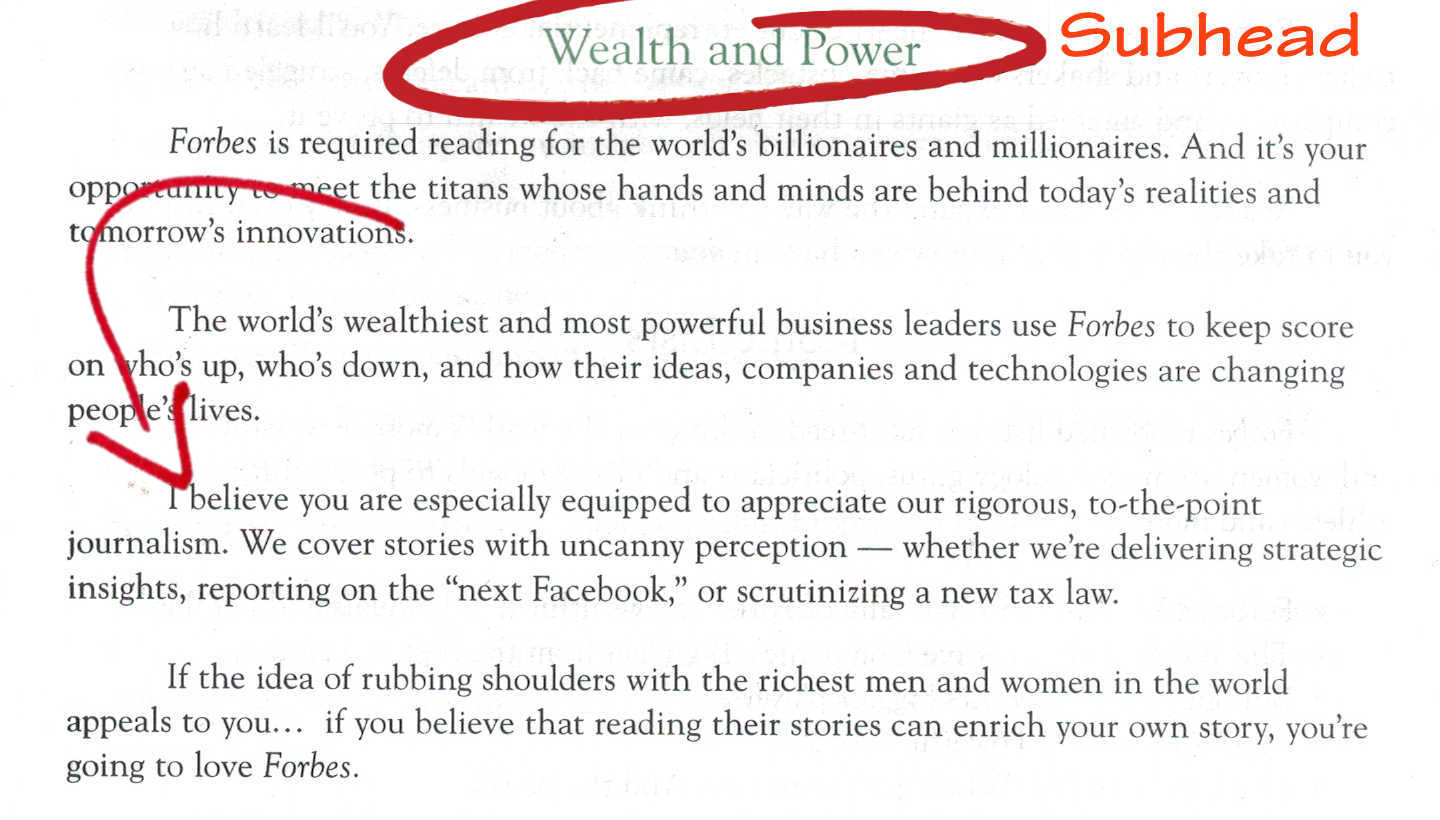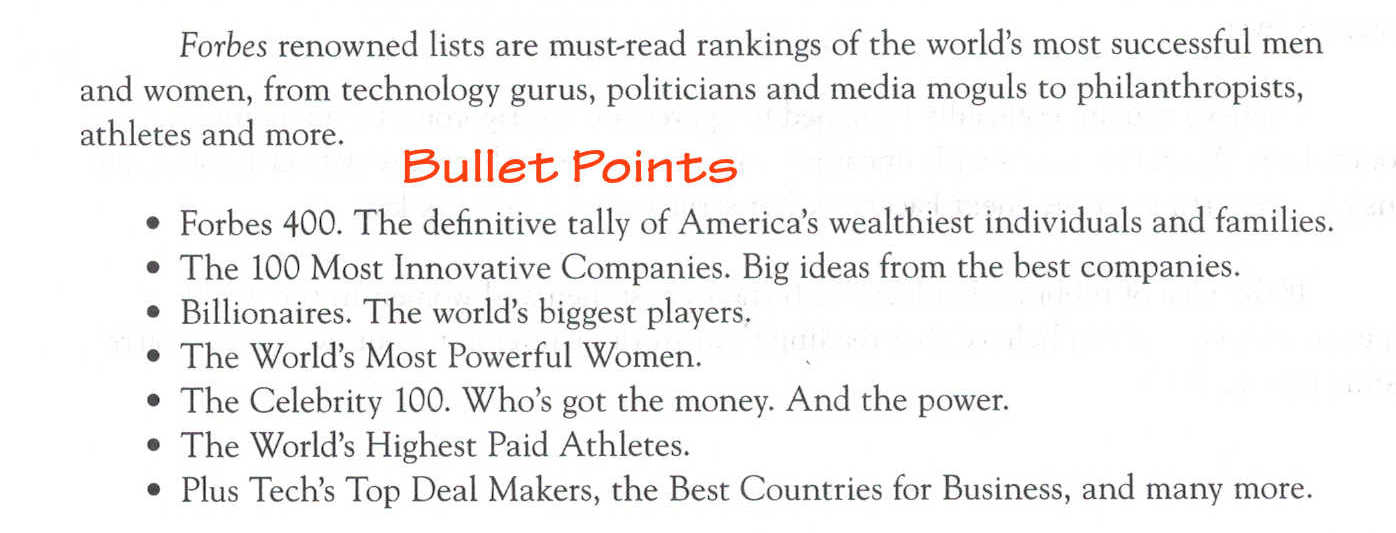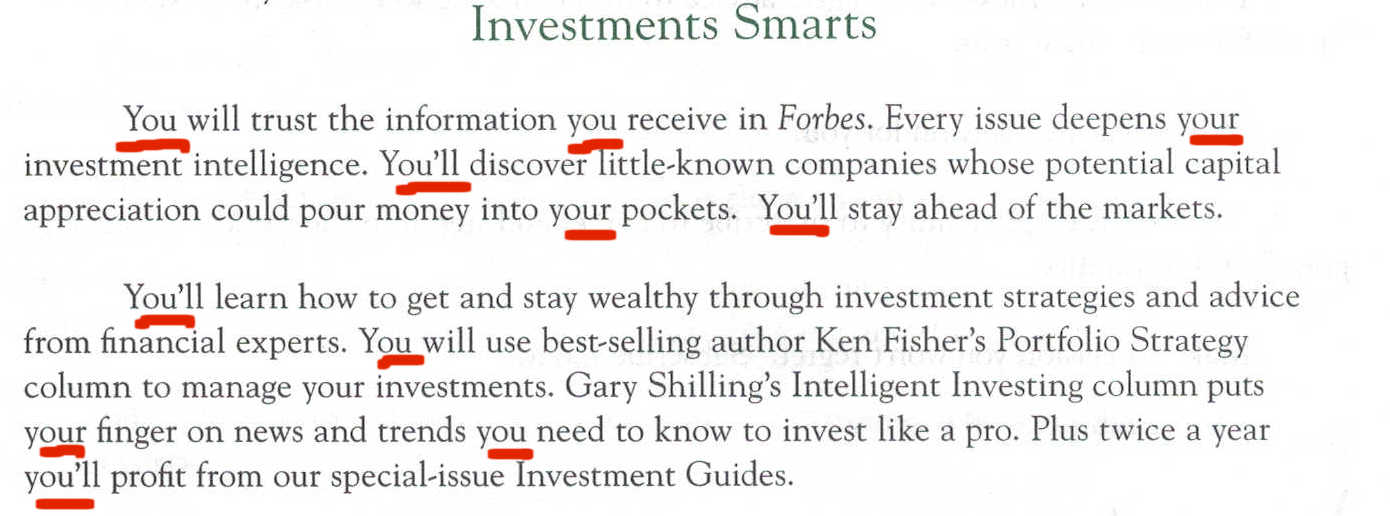This is Part II of an in – depth analysis of a sales letter I received a few weeks ago from Forbes Magazine. To read Part I go to this post: Autopsy of a Sales Letter Part I
Where’s the Evidence?
Most sales letters usually have some sort of evidence in them to prove they can do what they are saying they can do. You will normally see all sorts of testimonials in them from happy customers and clients that reinforce the claims are being made. However, in the Forbes sales letter there aren’t any.
If you are in business of any kind and have never heard of Forbes magazine, then you’ve probably been living in a cave. It has been an industry standard for decades so it is relying on its reputation in the market place for evidence.
When your company, business, or in this case, magazine reaches that magnitude of influence in the market place, you really don’t need testimonial; as a matter of fact, that may be a step down. So even though evidence in the form of testimonials isn’t present, you still know it’s there because of Forbes reputation.
Step 5 – Break Down the Sections
The next step in shredding this piece down to see why it works, is to take a good look at the individual sections and see what makes each of them tick. As a part of this letter’s formatting, you can see that the paragraphs and sections are short ― about two sentences in length. However, the writer has packed each short paragraph with important points that lead to the sale.

In the “Wealth and Power” section, each part reinforces the idea that the world’s most powerful business leaders are reading Forbes. However, in the third paragraph, the writer brings you, the reader, into the picture.
“I believe that you are especially equipped to appreciate our rigorous, to-the-point journalism.”
That is a subtle yet powerful draw in the prospect’s mind because it is telling him or her that they are made of the same stuff these titans of business are. Think about it. You have the Editor-in-Chief of one of the most powerful business magazine’s on the planet telling you that, “I believe you are especially equipped…”
If you read further in this section, you’ll see that the writer has taken the time to do this again. Look at the last paragraph of this exhibit. As I mentioned earlier, “rubbing shoulders with the richest men and women in the world…” is a very powerful and dramatic picture to paint in the mind of your reader. But take a look at the line right after that. “…if you believe that reading their own stories can enrich your own story, you’re going to love Forbes.”
You’ll notice that the copywriter hasn’t resorted to sounding at all like a salesman, while drawing you in. If he had written, “Do you want to be a titan of business like these giants? Then you’ll want to subscribe to Forbes!” you’d hear breaks squealing in your mind as you quickly recognized a sales pitch being made.
The next part of this section goes over many of the business articles and features, using an underlined format to set each one apart from the other; he is also using varied formatting to break up the information. After these features, the letter brings you into the picture using phrases like. “You’ll learn…”, and “It may even inspire you to take the next big step you know you have in you.” I underlined that last part because the psychology behind it is to give the prospect the notion the idea of, “Hey, if they did it, why can’t I?” The real genius behind a good sales letter is to be subtle and suggest things rather than be overt, like many of the online sales pages that you see on sites like Clickbank.
Why Bullet Points are Important
The next section “Iconic Lists” you can easily see that the writer listed the most important features of Forbes Magazine and then placed those features into bullet lists. Bullet points are great for two reasons, keeping the copy brief while delivering a feature or a promise.
Even though I’ve personally used longer bullets in the past, the main idea of writing them is to promise your prospect something while keeping the information short and sweet. In the case of this letter, you can easily see the top features of Forbes Magazine in a series of short statements. Since Forbes is a rather large magazine with a ton of features, presenting them in this format is smart. Any businessman or entrepreneur with limited time could easily glance at these bullets and find something that would interest him or her.
Another reason why I believe that this letter was written by a very experienced copywriter is the formatting of the bullets. Take a look at Exhibit 7 and see if you can spot any similarity from one bullet to the next.

Yep, you got it! They are all one line in length. A good copywriter will make sure that each of the statements are one line long or multiple lines long but not a mixture of different formats.
These statements all have a similar purpose too; they are displaying the authority of the magazine. If you look at the usual sales letters you see online or get in the mail, you’ll notice that the bullet statements are usually written to spike your curiosity and get you to read the rest of the sales letter.
In this case, since Forbes is a well-known authority in the world of business publications, they didn’t use the typical testimonials that most sales letters are loaded with. To keep this sales letter looking as much as a piece of personal correspondence and to ensure it was brief and only four pages long, Forbes is reflecting its authority through these bullet statements.
Putting “You” Into the Picture Even More
The “Investment Smarts” section could be easily blown off as another bullet-type section, since the second part of it is short sections that are all symmetrical one sentence features of the magazine. I would like to focus on the first part of it because there is a very important key to this sales letter’s success. Since we’re getting to the end of the letter, it is important to ramp up the sales process a bit and this letter does that by talking about the most important person in the room, you. Take a look at Exhibit 8.

Within six sentences the word “you” or a variation of it was used eleven times! “You” is an extremely powerful word in advertising and it is the direct opposite of the word “we” in writing copy. Just to drive home the point, let’s look at some of the world’s most famous advertising phrases:
- Fresh pizza delivered to your door in 30 minutes or it’s free! (Domino’s Pizza)
- Be all you can be (United States Army)
- A little dab’ll do ya. (Brylcreem TV Commercial 1950’s)
- What would you do for a Klondike Bar?
- You’re in good hands with Allstate
- You’re gonna love the way you look (Men’s Wearhouse)
- Have it your way, have it your way! (1970’s song from Burger King)
- You deserve a break today! (McDonald’s)
Just to drive the point home further, take a look at my favorite Old Spice commercial and see how many times the word “you” is used.
https://www.youtube.com/watch?v=Af1OxkFOK18
As a matter of fact, the word “you” is considered to be the most powerful word in copywriting and it ranks right up there with the words “free” and “new”.
The reason why this word is so important in the selling process is because almost everyone on the planet wants to know what is being offered to them. A huge mistake most bloggers and inexperienced copywriters make is not focusing on the reader and talking about themselves. As I said earlier, the word that is the direct opposite of you in copywriting is “we”. The other dangerous words are “me” and “I”. About the only time those words work is when you are making a promise or a guarantee.
- “I guarantee you’ll get results, or I’ll double your money back!”
- “I promise to deliver your letter within 4 days.”
About the only sales slogan I can think of recently that uses the word “we” in it is from the Farmers Insurance Company commercial.
We are Farmers – (The rest of the jingle is singing.)
Years ago, Avis Rental Car used, “We try harder”, but that’s about the only two times I can remember the word “we” being used in a company slogan. So the word “you” was the important emphasis in this sales letter before coming to…
The Infamous Call to Action
Many copywriters pine over this section as much, or even more than the headline in writing advertising copy. The famous copywriter, Gary Halbert, was known for investing massive amounts of time writing the call to action sections and order form parts of his ads. The amount of detail he’d put into the call to action section bordered on insane obsession.
However, with this particular sales letter, the call to action is rather sparse. As I mentioned earlier in this analysis, the main thrust or premise of this letter was that subscribing to Forbes Magazine will have you on par or on the same level as famous millionaires and billionaires.
So, “Rub Shoulders with the World’s Richest and Most Powerful…” is the big appeal of this direct marketing piece. The part that follows that statement is cleverly written to where it doesn’t feel like you’re being sold to but you are being given a chance to join the elite.
“You have the opportunity to subscribe to Forbes..” (See Exhibit 9)

My only criticism of this piece is that the call to action/ordering information is pretty weak. When I got this piece in the mail, I don’t recall getting a subscription card with it.
Maybe I dropped it or didn’t notice it, but I can’t seem to locate it; this brings me to the weakness in this letter – which is a very weak ordering process. The last page of this letter has an entire quarter of the page blank. In my opinion, it could have had a rather large 1-800 number that you could easily call plus a website address that was optimized for easily subscribing or at the very least, collecting email addresses.
The postscript says “Act now!” but there is no information on where or how to act. Since there isn’t a reference to an order card in the letter at all, I don’t even know if for sure if I got one.
The best situation to have in ordering a product, or in this case, a subscription would be to have multiple ways that you can order. Sending in a subscription card, a 1-800 number, and a web address where you can order all three options together would have been the best possible strategy for sealing the sale.
Conclusion
I have no idea who the copywriter is that wrote this letter for Forbes magazine. Judging by the fact that Forbes is a premier business periodical and an industry-standard, I would say the writer they hired was extremely experienced and expensive. If you have any comments or thoughts you’d like to add to this analysis please leave a comment below.
